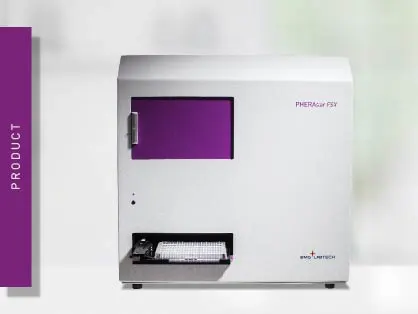
PHERAstar FSX
Powerful and most sensitive HTS plate reader
The dual-luciferase reporter assay (DLR) system such as the Promega E1910, allows simultaneous expression and measurements of both firefly (Photinus pyralis) and renilla (renilla reniformis or sea pansy) luciferases within a single sample using a luminometer with 2 injectors.
 Dr Manoja Rasamanikkam
Dr Manoja Rasamanikkam
The firefly experimental reporter is correlated with the effect of specific experimental conditions, while the activity of the co-transfected renilla control reporter provides an internal control that serves as the baseline response. Normalisation of the firefly activity to the renilla activity minimises any experimental variability caused by differences in cell viability and/or transfection efficiency. Other sources of variabilities such as differences in pipetting volumes, cell lysis efficiency, and assay efficiency are also effectively eliminated. Normalisation increases data accuracy by minimising experimental variability providing a more reliable interpretation of the experimental data. Reading both luciferases simultaneously from the same samples reduces plates and time without compromising on the quality of data.
The DLR is very widely used to study the interference of specific proteins on various signalling pathways and is typically measured with a luminescence plate reader equipped with injectors. For example, DLR has been adapted by virologists to test whether specific viral proteins have an antagonistic role in the Interferon system. The immune response to viral infection consists of both the innate and the adaptive defences. The adaptive response consists of antibodies and lymphocytes referred to as the humoral response and the cell-mediated response, respectively. Both humoral and cell-mediated responses are essential for antiviral defence. However, many viral infections are halted by the quick innate immune response; specifically the interferon system, particularly the type I Interferon system. The Interferon system is considered the primary antiviral response and is the first line of defence against viruses.
The detection of pathogen-associated molecular patterns (PAMPs) by pattern recognition receptors (PRRs) on or in the infected host cell leads to the activation of downstream signalling pathways leading to an induction of type I IFN. Viral PAMPs are nucleic acids with structures generated by viruses and not found in normal uninfected host cells, such as double-stranded RNA (dsRNA) or exposed/uncapped short dsRNA with 5’-triphosphate (Randall and Goodbourn, 2008). Secreted IFN can then act in an autocrine and/or paracrine manner by binding to its receptor on the infected cell and/or on the neighbouring cells, leading to the activation of the Janus kinase (JAK)/ signal transducers and activators of transcription (STAT) signalling pathway (Collins and Mossman, 2014). Activation of the JAK/STAT signalling pathway leads to the transcription of hundreds of IFN stimulated genes (ISGs). ISGs encode proteins that mediate antiviral effects such as cell death, mRNA degradation, translational arrest and up-regulation of antigen presentation in preparation for the adaptive immune response (Audsley and Moseley, 2013).
To survive and replicate within their hosts, viruses must be able to evade the interferon system. The viruses can evade the IFN system by interfering with the induction pathway or the signalling pathway of IFN; the JAK/STAT pathway which leads to the induction of ISGs. Therefore, viral proteins that modulate virus-induced IFN response should be considered as candidates for managing virus infection (Randall and Goodbourn, 2008).
For assaying modulation of the IFN induction pathway, the cells are co-transfected with a reporter containing the promoter region from IFN upstream of a firefly luciferase gene, the transfection control renilla reporter and an expression vector encoding the viral gene of interest (left image). After 32 hours the cells are stimulated with synthetic dsRNA; polyinosinic: polycytidylic acid (poly (I: C)). The cells are lysed and the firefly and renilla luciferase activities are read after 16 hours of stimulation.
For assaying modulation of JAK/STAT signalling pathway, the cells are co-transfected with a reporter containing the promoter region from ISG upstream of a firefly luciferase gene, the transfection control renilla reporter and an expression vector encoding the viral gene of interest (right image). After 42 hours the cells are stimulated with IFN. The cells are lysed and the firefly and renilla luciferase activities are read after 6 hours of stimulation.
In virology, the DLR system is also widely used to study the replications of viruses, refer to application note: Dual-luciferase assay to assess the replication of the hepatitis C virus subgenomic replicon Using additional luciferases, with different emission peaks allow to set up huge luminescence multiplexing approaches using six different readouts. With the help of the CLARIOstar or VANTAstar and their luminescence spectral scanning feature, ideal combinations of different luciferase to be used in the same run can be identified.
Using additional luciferases, with different emission peaks allow to set up huge luminescence multiplexing approaches using six different readouts. With the help of the CLARIOstar or VANTAstar and their luminescence spectral scanning feature, ideal combinations of different luciferase to be used in the same run can be identified.
Powerful and most sensitive HTS plate reader
Most flexible Plate Reader for Assay Development
Upgradeable single and multi-mode microplate reader series
Flexible microplate reader with simplified workflows
Nitration can significantly modify the structure and function of proteins in cells. But how can measurements of protein nitration reveal crucial information about biological activity and how can microplate readers help?
Second messengers play a pivotal role in signal transduction events in cells. But how do you measure these small, transiently lived molecules and how can microplate readers help?
NanoBRET is used to analyse binding events, signaling pathways and receptor trafficking in live cells and has significantly expanded the range and applications of BRET assays.
Calcium is one of the central players in biology. This blog explains some of the many roles of calcium and discusses the different ways that calcium ions can be measured on microplate readers.